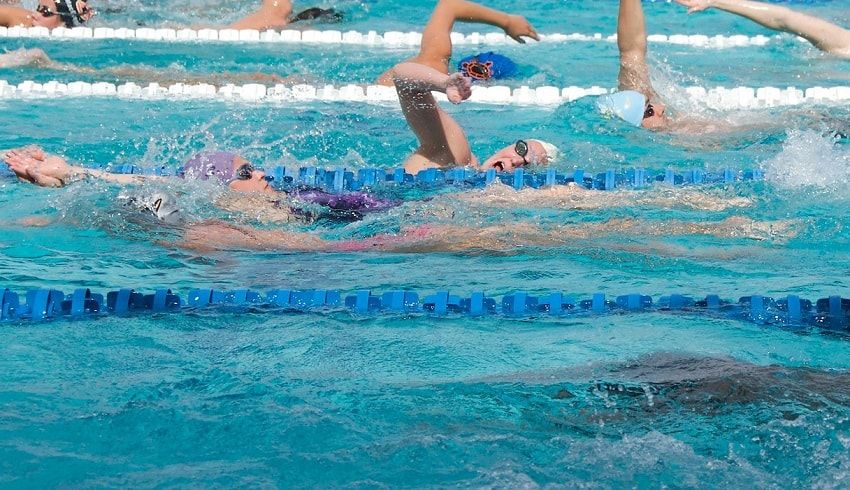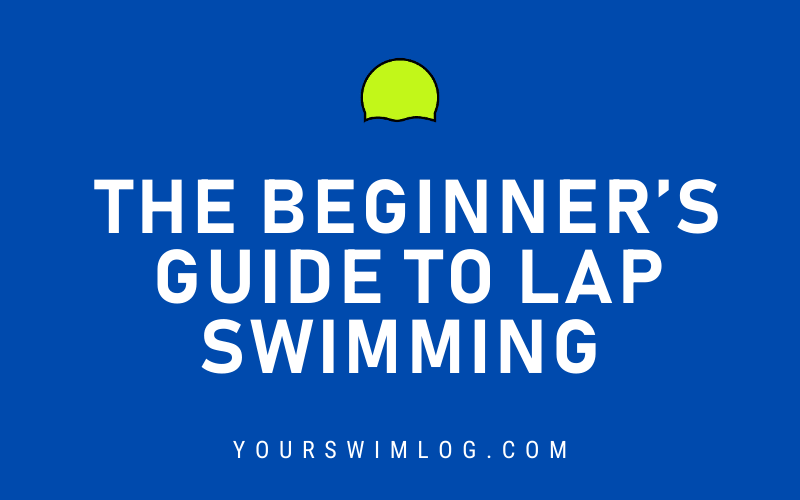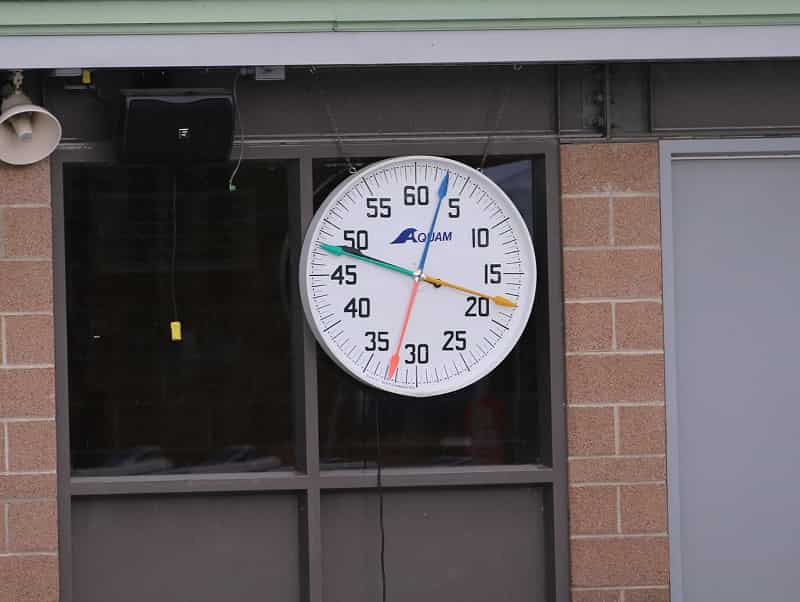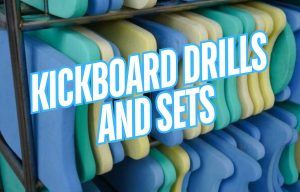
How to Use a Drag Chute for Faster Swimming
Looking for tips on how to use a drag chute for improved swim performances? Read on for some proven tips, sets, and pointers for training with a chute.

Want to start swimming? Here’s the beginner lap swimmer’s guide to everything you need to know about getting in shape and having fun at the lap pool.
Lap swimming.
Looks kinda boring, doesn’t it?
You grab your favorite pair of swimming goggles, a lap swimming suit, and off you go. Right?
But for those of us who have spent years and countless meters and yards toiling around the black line, we know differently.
Swimming is a fantastic activity/sport that comes with a metric heap of benefits. It’s low impact, an excellent form of cardio, and a way to build muscle across your whole body. (Swimming is also a sneaky way to burn A TON of calories.)
Crushing the laps can be done alone, with a friend, or you can train and compete with a club or team
Below are some key things to consider as you lace up your swim-suit and goggles and head on down to the lap pool.
Stuff like:
And more.
So let’s get after it!

You don’t need much gear to get started with swimming.
Here are the basics:
Yup, are gonna need a swim-suit!
You might be tempted to wear a bikini or board-shorts for lap swimming, but you will notice that with board shorts it will feel like you are swimming with a small child on your back, and most beach swimwear doesn’t keep things, umm, tucked in while you are churning up and down the pool.
Picking out the right swim-suit means comfort and durability. Look for training suits that are made of polyester. Pool chemicals tend to be harsh on most fabrics, but polyester is one of the few materials that can take a chlorinated beating.
For women, there is a variety of fits, sizes, and backs. You’ve got your basic women’s swim training suits, There are some decent two-piece training suits. And for the swimmer who is outside, and wants some additional sun protection, consider rocking out in one of our favorite rash guards for women. (Combine added coverage with a waterproof sun screen for maximum skin protection.)
For men who aren’t quite ready to don the “Speedo”—aka swim briefs—there are plenty of other types of suits, from a square-cut to swim jammers, which provide the same amount of coverage as a pair of bicycle shorts. You can check out some of my favorite lap swimming suits for men here.
Swim goggles help you see underwater, protect your eyes from pool chemicals and UV rays, and can even provide real-time workout metrics.
Goggles are ultimately a safety accessory, helping you see what’s happening around you in the pool. Things like other swimmers, the wall, backstroke flags, the pace clock. All easier to see when you strap a pair of swim goggles on your melon.
For those of you lucky enough to be swimming outdoors, goggles also provide protection against the sun (look for mirrored tinted goggles—they protect your eyes and look badass, too).
There are a few different options for the best swimming goggles, but one of my favorites for beginners (and more experienced swimmers) is the Speedo Vanquisher 2.0, as the goggles are comfortable, durable, and don’t leak.
The Vanquisher 2.0 swim goggles are made with silicone straps and a rubberized gasket that sits softly and securely on your face, and are available with a prescription, sizes for junior swimmers, and in a multitude of colors and tints.
Swimming caps are a slightly misunderstood piece of swim apparel. They don’t keep your hair dry, can feel like your head is getting popped like a pimple, and some caps, when you take them off, will catch and grab your hair, making it feel like someone is ripping your hair by the ends.
So why on earth should you wear a swim cap?
Well, for starters, a swim cap will protect your hair from chlorine and harsh pool chemicals. It will keep your hair out of the pool and out of the gutter/other swimmer’s faces. And for you swimmers with long hair, a cap will keep your hair out of your face.
There are the bare essentials.
There’s other stuff too:
Okay, so you have got yourself a swim-suit, goggles, and a swim cap. You head down to the pool, find a speed-appropriate lane, hop in, and start dummying laps like they stole your lunch money.
Not so fast, cowboy.
Here are some pointers and thoughts on how to make that sweet new lap swimming routine sustainable.
Mix up your strokes to keep your shoulders happy. Swimming, particularly the overhead arm rotations, is an unnatural movement for humans. Alternate freestyle (front crawl) with backstroke and breaststroke during your time in the water to give your shoulders a mix of stress and stimulus. Swimmer’s shoulder is no joke, and is prevalent even in highly trained swimmers.
Warm-up and warm-down. Swimming, even though it is in water, is still a load-bearing exercise. Especially them over-head movements we just talked about. Make sure to warm-up properly with lots of arm swings on dryland, and ease into your swim workout, steadily turning up the intensity. Warming down helps kick-start recovery and allows you to come down physically and mentally after your training session.
Use intervals. Intervals never get old. I’ve been swimming for 30-years and still structure my swim practices around them. Instead of going to the pool and cranking out 1,500-meters straight, and watching your technique disintegrate like a paper mache swimsuit, break your workout into 15×100-meters. You will hold a faster overall pace, and more importantly, your technique will stay together longer.
Tip: Use rest periods instead of strict time intervals for your reps. (Check out these three comprehensive swimming workouts for beginners, including suggested rest periods and training tips.)
Crank up the volume slowly. I mentioned it earlier, but it bears worth repeating: the goal with your new lap swimming routine is sustainable progress. I can totally understand the instinct to go full-blast on week one. Temper that urge and slowly increase the volume and intensity of your lap swimming. A handy rule is to not increase work by more than 5-10% during those first few weeks.
Reflect and evaluate your training. I am a life-long log-booker of my swim practices. I find it therapeutic to reflect and evaluate on my training sessions after I get out of the water. I have a place to recognize my successes, acknowledge areas of improvement, and see how much I have progressed. Using a training log also allows you to chart future training so that you are constantly working towards getting better and faster.
Speed isn’t everything. I know, the way we measure ourselves up against other swimmers in the water is on the clock. It’s a clear indicator of who the faster swimmer is. But lap swimming isn’t just about swimming fast, it’s about enjoying the process of swimming well. Don’t worry about swimming “slow”—it’s actually much harder to swim deliberately slow than it is to swim “hard.” Swimming is a sport that exponentially rewards deliberate effort and efficiency. Just cause you aren’t the fastest swimmer in the pool doesn’t mean you can’t be technically awesome.

Like most sports, swimming has its own language and shorthand.
As you build up the meters/yards, you will start to hear a whole lot of terms and phrases that on the surface (swim pun!) don’t make a lot of sense!
Descending effort? On the top? Negative split? Huh?
Here are a handful of the essentials for lap swimmers:
Circle swimming: In order to accommodate multiple swimmers, everyone will swim up one side of the lane, and back the other side of the lane. You know that black line at the bottom of the lane? Swim around that. Avoid swimming up and down the black line when other swimmers are in the lane, lest you feel hungry for a swimmer-on-swimmer collision.
Splitting the lane: When two lap swimmers agree that they will swim up and down their respective side of the lane. If a third person arrives and wants to share the lane, everyone in the lane reverts to circle swimming.
Long course pool: You know those big-ass pools Olympians race in? Those are 50-meters long. They are the standard length for the high-level swim meets, including the Olympics and World Championships. There are lots of benefits to long course swimming, prominently that it is more challenging.
Short course yards: Most pools in the United States are in short-course yards (25 yards in length).
Short course meters: Some pools in the United States (not many), and almost all short course pools elsewhere in the world have short course pools that are measured in meters.
Pace clock: Sometime it’s analog, sometimes it’s digital, in both cases, it sits pool-side, quietly running through the seconds and minutes and judging you. Although many lap swimmers (particularly triathletes) use Garmins or other multisport watches to track their times and send-offs, learning to use the pace clock is a skill every lap swimmer should eventually acquire.
Lap swimming etiquette: Just like your local freeway, lap swimming pools have rules and guidelines to follow. Lanes are generally assigned by speed (Fast, Moderate, Leisure, etc), and rules are almost always posted somewhere visible. Take a moment to familiarize yourself with them. Share the lane, be courteous when passing (or being passed), and please don’t pee in the pool. (Here is more on lap swimming etiquette.)
Here are some commonly asked questions beginners have when it comes to lap swimming:
Laps vs. lengths in the world of swimming terminology is a debate that rages to this day.
Laps and lengths are almost entirely the same thing, one simple length of the pool, regardless of the distance.
The confusion arises when people use the cycling and track term “laps” to denote returning to the starting point to complete a full circuit.
According to international and national governing bodies including FINA, USA Swimming, Swimming Canada, just about every swimmer and swim coach, and even swim tracking devices like Apple Watches, a lap and a length are the same.
Lap swimming, whether for a break from the modern world, or for exercise, or to rekindle that competitive instinct in competitions, is an intensely rewarding activity.
Swimming has given me so much more than broad shoulders and a voracious appetite. It’s my daily source of meditation. It’s a place where I can go and be alone with my thoughts, my breath, and my soul (I know, tacky—so sue me).
So welcome to this most amazing and satisfying of activities.
Set goals. Work at incremental improvement. Enjoy the process of improvement.
See you at the pool : )
How to Start Swimming for Exercise. Getting started with this wonderful sport can feel intimidating. Here’s your starter kit for getting started with lap swimming.
What are the Four Swimming Strokes? (Differences, Features, History, and More). Curious about the swimming strokes and their main differences? Here’s a closer look at the four strokes, including key features, history of each, and more.

Olivier Poirier-Leroy Olivier Poirier-Leroy is the founder of YourSwimLog.com. He is an author, former national level swimmer, two-time Olympic Trials qualifier, and swim coach.
✅ Free shipping on Orders over $49
✅ Price Match Guarantee
✅ Best selection of gear for training and competition
✅ Fast and Easy Returns

“This is the best book I have ever seen concerning mental training.” — Ray Benecki, Head Coach, The FISH Swim Team


Looking for tips on how to use a drag chute for improved swim performances? Read on for some proven tips, sets, and pointers for training with a chute.

Ready to take your swimming to the next level? Here are seven ways that a drag chute can help you become a better and faster swimmer.

Wondering if a swim bench can help improve your swimming? Here are six benefits of swim benches for better technique, more power, and faster swimming.

Not breathing into the walls is one of the fundamental skills developing swimmers are taught. Here is how powerful a no-breath approach is for turn and swim speed. Strong training habits are something swimmers hear a lot about from their earliest days of their competitive swimming careers. The greatest hits

Drills with a swim snorkel are one of the best ways to maximize engagement and skill development. Here are five swim snorkel drills to try for faster swimming.

Looking to add some flavor to your kick sets and workouts? Here are some kickboard drills swimmers can use for faster swimming.
SITE
SHOP
GUIDES

LANE 6 PUBLISHING LLC © 2012-2025
Join 33,000+ swimmers and swim coaches learning what it takes to swim faster.
Technique tips, training research, mental training skills, and lessons and advice from the best swimmers and coaches on the planet.
No Spam, Ever. Unsubscribe anytime.
